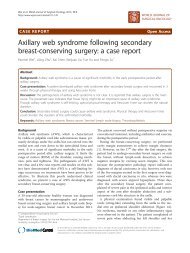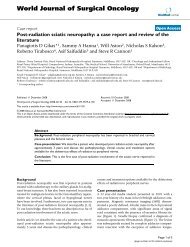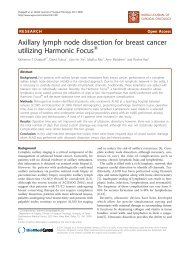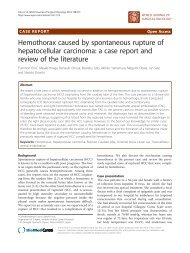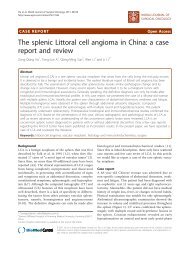Case of spontaneous regression of carotid body tumor in a SDHD ...
Case of spontaneous regression of carotid body tumor in a SDHD ...
Case of spontaneous regression of carotid body tumor in a SDHD ...
Create successful ePaper yourself
Turn your PDF publications into a flip-book with our unique Google optimized e-Paper software.
Hammer et al. World Journal <strong>of</strong> Surgical Oncology 2012, 10:218 Page 2 <strong>of</strong> 4<br />
http://www.wjso.com/content/10/1/218<br />
Figure 1 Transverse gadol<strong>in</strong>ium-enhanced 3D time <strong>of</strong> flight<br />
magnetic resonance angiography images at basel<strong>in</strong>e <strong>in</strong> 2004<br />
show the bilateral <strong>carotid</strong> <strong>body</strong> <strong>tumor</strong>s (arrows).<br />
exam<strong>in</strong>ation <strong>in</strong> a regional hospital had revealed bilateral<br />
<strong>carotid</strong> <strong>body</strong> <strong>tumor</strong>s. She had discovered a swell<strong>in</strong>g <strong>in</strong><br />
the right neck s<strong>in</strong>ce 6 months before, and only after<br />
question<strong>in</strong>g mentioned a long-exist<strong>in</strong>g pulsatile t<strong>in</strong>nitus<br />
on the right side. The family history for paragangliomas<br />
was positive: her father and uncle were affected.<br />
Physical exam<strong>in</strong>ation revealed a small reddish <strong>tumor</strong><br />
<strong>in</strong> the right middle ear, with positive Brown’s sign and a<br />
<strong>tumor</strong> <strong>in</strong> the right neck at the level <strong>of</strong> the hyoid bone;<br />
on the left side there was no palpable lesion. The lower<br />
cranial nerves were <strong>in</strong>tact and the hear<strong>in</strong>g was normal.<br />
In general exam<strong>in</strong>ation, the patient was all-over obese<br />
(weight 121 kg, length 1.75 m, <strong>body</strong> mass <strong>in</strong>dex 39.5),<br />
blood pressure was 130/70 mm Hg, pulse rate 80/m<strong>in</strong>.<br />
There were no other abnormalities. Ur<strong>in</strong>ary excretion<br />
(24-h sample) <strong>of</strong> catecholam<strong>in</strong>es was repeatedly normal.<br />
Germl<strong>in</strong>e mutation analysis <strong>in</strong> DNA from a blood sample<br />
demonstrated a mutation <strong>in</strong> <strong>SDHD</strong> (P-Asp92Tyr).<br />
MRI <strong>in</strong>clud<strong>in</strong>g a gadol<strong>in</strong>ium-enhanced 3D time-<strong>of</strong>flight<br />
MR angiography sequence [8] was acquired at our<br />
<strong>in</strong>stitution <strong>in</strong> April 2004, and revealed hypervascular enhanc<strong>in</strong>g<br />
lesions <strong>in</strong> the <strong>carotid</strong> bifurcation bilaterally,<br />
consistent with <strong>carotid</strong> <strong>body</strong> <strong>tumor</strong>s. The maximum<br />
transverse diameter was 23 mm on the right and 12 mm<br />
on the left (Figure 1). A tympanic <strong>tumor</strong> was identified<br />
on the right side.<br />
The right <strong>carotid</strong> <strong>body</strong> <strong>tumor</strong> was surgically resected<br />
<strong>in</strong> 2004, followed by extirpation <strong>of</strong> the tympanic <strong>tumor</strong><br />
<strong>in</strong> 2005. No radiotherapy was applied. There were no<br />
complications from the surgical procedures. In the<br />
postoperative phase a severe obstructive sleep apnea<br />
syndrome (OSAS) was diagnosed, for which she started<br />
cont<strong>in</strong>uous positive airway pressure (CPAP) therapy.<br />
In 2005 she started thyroid hormone suppletion for<br />
Hashimoto disease. Between 2005 and 2008, the patient<br />
<strong>in</strong>tentionally lost weight from 136 kg to 93 kg, because<br />
<strong>of</strong> a pregnancy wish which was eventually unsuccessful.<br />
Dur<strong>in</strong>g follow-up the patient rega<strong>in</strong>ed <strong>body</strong>weight <strong>in</strong><br />
2010 to 129 kg. In 2011 she suffered anamnestically<br />
from a transient ischemic attack (with no abnormalities<br />
on imag<strong>in</strong>g studies), after which she started stat<strong>in</strong><br />
treatment and therapy with carbaselate calcium and<br />
dipyridamole.<br />
Follow-up MRI was performed with 2-year <strong>in</strong>tervals<br />
(Figure 2), and showed no evidence <strong>of</strong> recurrence on the<br />
operated sites. Between 2004 and 2008 there were no<br />
changes <strong>in</strong> size and enhancement pattern <strong>of</strong> the left<br />
<strong>carotid</strong> <strong>body</strong> <strong>tumor</strong> and therefore surgical resection was<br />
considered unnecessary. Unexpectedly, <strong>in</strong> 2010, the<br />
<strong>tumor</strong> was significantly smaller, and showed reduced<br />
enhancement <strong>in</strong> the center <strong>of</strong> the lesion, consistent<br />
with necrosis. Follow-up exam<strong>in</strong>ations <strong>in</strong> June 2011 and<br />
September 2011 showed nearly complete <strong>regression</strong>,<br />
Figure 2 Transverse gadol<strong>in</strong>ium-enhanced 3D time-<strong>of</strong>-flight magnetic resonance angiography images at subsequent <strong>in</strong>tervals show<strong>in</strong>g<br />
the <strong>carotid</strong> <strong>body</strong> <strong>tumor</strong> on the left <strong>in</strong> 2006 (A), unchanged <strong>in</strong> 2008 (B), <strong>in</strong>homogeneous r<strong>in</strong>g-like enhancement <strong>in</strong> 2010 (C), and further<br />
<strong>regression</strong> <strong>in</strong> 2011 (D). On the image only a subtle l<strong>in</strong>ear enhancement is noted, no evidence <strong>of</strong> an enhanc<strong>in</strong>g mass could be detected.



